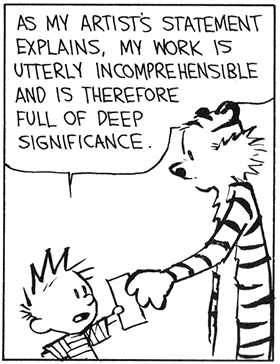8 Artist Statements We Love

Artist statements we love
Calvin & Hobbes on artist statements. Cartoon by Bill Watterson, July 15, 1995
“Hey, that was a good artist statement!”
It’s a sentiment you don’t hear very often, and yet it’s what we found ourselves saying after reading the statements below. Artist statements don’t have to be a source of fear (for the writer) and boredom (for the reader)! See a few examples of strong artist statements below, and below that, a discussion of what makes them good.
Artist statements
Andy Yoder, sculptor: “Many people take great comfort in the bathroom towels being the same color as the soap, toilet paper, and tiles. It means there is a connection between them, and an environment of order. Home is a place not only of comfort, but of control. This sense of order, in whatever form it takes, acts as a shield against the unpredictability and lurking chaos of the outside world.
My work is an examination of the different forms this shield takes, and the thinking that lies behind it. I use domestic objects as the common denominators of our personal environment. Altering them is a way of questioning the attitudes, fears and unwritten rules which have formed that environment and our behavior within it.”
Nancy McIntyre, silk screen artist: “I like it when a place has been around long enough that there is a kind of tension between the way it was originally designed to look and the way it looks now, as well as a tension between the way it looks to whoever is caring for it and the way it looks to me. Trouble is, the kinds of places I find most appealing keep getting closed or torn down.
What do I want to say with my art?
Celebrate the human, the marks people make on the world. Treasure the local, the small-scale, the eccentric, the ordinary: whatever is made out of caring. Respect what people have built for themselves. Find the beauty in some battered old porch or cluttered, human-scale storefront, while it still stands.”
Artist statements
(Was this post helpful? For more resources, subscribe to The Art League Blog newsletter here or check out our Artful Resources archive.)
Dawn Benedetto, jeweler: “Poppi is my fun and clever alter ego. It’s a line of jewelry that doesn’t take life too seriously. The glass and sterling rings are my invention and are unique in that they stretch to fit most everyone. Poppi adds a splash of color to jeans or an extra spark to ignite a little black dress; heck, it’ll even brighten up a trip to the grocery store.
If nothing else, it’s a statement. Poppi laughs. Poppi flirts. Poppi screams. Poppi says it all without you saying a thing.”
Diana Chamberlain, ceramicist: “I work in porcelain for its suppleness, delicacy and strength. Porcelain’s willingness to be transformed, both in form and texture, makes it a perfect medium for exploring the iconic meaning of dress and the concept of shelter.”
Margaret Cerutti, painter: “Capturing the light is everything! As a plein air painter, it is always the light that I remember most about any location. It is my inspiration.
Its elusive quality can transform a figure or a landscape in just a matter of seconds. I strive to convey that sense of place by capturing its fleeting magic.”
Artist statements
Alison Sigethy, glass artist: “Getting outside is good for the soul. Through my artwork, I try to bring the outside in. While I make no attempt to portray actual plants or animals, I do want my creations to look like they could have lived or grown somewhere. Living with beautiful objects that pay tribute to the natural world reminds us to slow down and helps us reconnect with nature.”
Charlene Fuhrman-Schulz, sumi-é artist: “My subject matter is nature, whether it is a traditional landscape or a bird and flower painting. I use traditional materials, ink and brush on rice paper, to capture movement and life — making the brush dance and the ink sing. Everything is captured in the spontaneous dance and movement of the brush as it meets the rice paper. There is no going back and correcting when painting with ink and rice paper.”
Pete McCutchen, photographer: “I decontextualize. Then, I reconstruct.
Looking past the obvious, close observation and engagement of the subject is my process. The challenge is to see beyond the distraction of the conspicuous to capture its unique self. Some of my subjects are quite beautiful, others less so. My goal is to inspire those who see my work to look more carefully at the world around them, to discover beauty in unusual places.”
So what makes these artist statements work?
What these artist statements do
keep it short
grab the reader’s interest with the first sentence
introduce the author’s personality and enthusiasm
give a hint about the why of the artwork
use the first person (I, me, mine — this is not a strict rule, but it does seem to help the author write a more straightforward, readable statement)
What these artist statements don’t do
summarize the resume found elsewhere on the website
give a physical description of artwork photographed elsewhere on the website
sound generic
use “art speak”
Some questions to think about when writing your statement
What keeps you coming back to the studio, day after day?
What’s the best way someone has responded to your artwork (comment in a guest book, at an exhibit, etc.)
What questions are you asked most frequently about your work?
What’s your artist story? (as opposed to your biography and CV)
Who is your art for?
I upvoted your post.
Best regards,
@Council
Posted using https://Steeming.com condenser site.